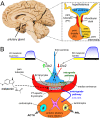Enlightened: addressing circadian and seasonal changes in photoperiod in animal models of bipolar disorder
- PMID: 34226504
- PMCID: PMC8257630
- DOI: 10.1038/s41398-021-01494-5
Enlightened: addressing circadian and seasonal changes in photoperiod in animal models of bipolar disorder
Erratum in
-
Correction: Enlightened: addressing circadian and seasonal changes in photoperiod in animal models of bipolar disorder.Transl Psychiatry. 2021 Jul 21;11(1):400. doi: 10.1038/s41398-021-01521-5. Transl Psychiatry. 2021. PMID: 34290224 Free PMC article. No abstract available.
Abstract
Bipolar disorders (BDs) exhibit high heritability and symptoms typically first occur during late adolescence or early adulthood. Affected individuals may experience alternating bouts of mania/hypomania and depression, with euthymic periods of varying lengths interspersed between these extremes of mood. Clinical research studies have consistently demonstrated that BD patients have disturbances in circadian and seasonal rhythms, even when they are free of symptoms. In addition, some BD patients display seasonal patterns in the occurrence of manic/hypomanic and depressive episodes as well as the time of year when symptoms initially occur. Finally, the age of onset of BD symptoms is strongly influenced by the distance one lives from the equator. With few exceptions, animal models useful in the study of BD have not capitalized on these clinical findings regarding seasonal patterns in BD to explore molecular mechanisms associated with the expression of mania- and depression-like behaviors in laboratory animals. In particular, animal models would be especially useful in studying how rates of change in photoperiod that occur during early spring and fall interact with risk genes to increase the occurrence of mania- and depression-like phenotypes, respectively. Another unanswered question relates to the ways in which seasonally relevant changes in photoperiod affect responses to acute and chronic stressors in animal models. Going forward, we suggest ways in which translational research with animal models of BD could be strengthened through carefully controlled manipulations of photoperiod to enhance our understanding of mechanisms underlying seasonal patterns of BD symptoms in humans. In addition, we emphasize the value of incorporating diurnal rodent species as more appropriate animal models to study the effects of seasonal changes in light on symptoms of depression and mania that are characteristic of BD in humans.
Conflict of interest statement
The authors declare no conflicts of interest in the preparation of this review article. They worked collaboratively in reviewing and assembling the relevant literature, discussing topics to include in the major sections of the article, and writing the article. They are responsible for its content.
Figures


References
-
- Vieta E, Berk M, Schulze TG, Carvalho AF, Suppes T, Calabrese JR, et al. Bipolar disorders. Nat Rev Dis Prim. 2018;4:18008. - PubMed
-
- Carvalho AF, Firth J, Vieta E. Bipolar disorder. N Engl J Med. 2020;383:58–66. - PubMed
-
- McIntyre RS, Berk M, Brietzke E, Goldstein BI, López-Jaramillo C, Kessing LV, et al. Bipolar disorders. Lancet. 2020;396:1841–56. - PubMed

